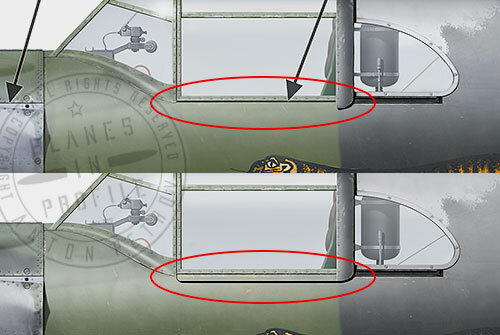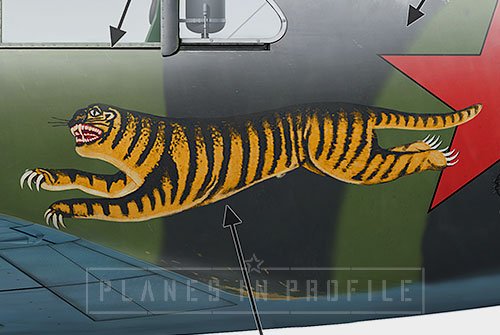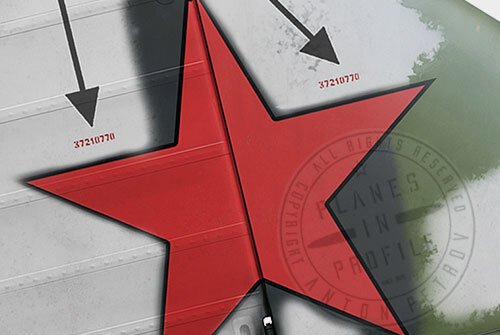Karabanov’s White-70 “Russian Tiger”
LAVOCHKIN, LA-5 (TYPE 37)
522-nd IAP, 215-th IAD, 2-nd IAK, 14-th Air Army, Volhovskiy Front, February 1943,
Flown by the commander of a squadron, captain Mikhail Nikolaevich Karabanov , Ace with 22 victories
Mikhail Karabanov was the best graduate of his aeroclub and passed his entry exam into the 2-nd Military aviation school for pilots in Borisoglebsk with flying colours. He graduated the aviation school in 1939 and remained working there for two years as an instructor-pilot, during which time he has trained 47 graduates.
Karabanov was described as having an insatiable love for flying and a talent for aerobatics. He was also naturally decisive, aware, brave and calculating, possessing all the right qualities for an excellent fighter pilot. These qualities led him to many victories in numerous air battles in his short career as a fighter pilot.
So great was Karabanov’s skill and reputation amongst the other fighter pilots defending the city of Leningrad during the siege, that they sometimes referred to the best amongst them by saying ; ‘He flies like Karabanov!’ [2]
The enemy also took note of Karabanov’s prowess, of his air battle style and of his airplane with the tiger painted on the fuselage. Allegedly, based on the stories of captured German pilots in the Leningrad region, there was an opinion amongst them that whoever will meet the ‘Russian tiger’ in the air will inevitably perish [2].
Sometimes the Soviet radio operators, tuning in to the waves of Luftwaffe’s radio communications, heard panicked warnings:
- Akhtung! Attention! Karabanov is in the sky! [3]
Infact, in the 1943 ‘Известия’ news paper article called ‘Гнев Карабанова’ (Gnev Karabanova, translates to ‘Karabanov’s wreath’ ), he is described as the ‘Best fighter pilot of the Volhobvkiy Front, a famed Ace’. [1]
Despite Karabanov’s skills and eventual achievements however, his first battle sortie of the war was very unlucky. His LaGG-3 was shot down and fell in the forest, into the snow. Karabanov counted about 300 bullet holes in it. For two days Karabanov walked back to his airfield, determined to avenge for this incident. The opportunity to do so came on the first day that he flew again after getting back to his regiment . That day Karabanov allegedly downed three enemy airplanes, two Junkers-88 and later that day one Me-109 [2] (Please note, this is not consistent with Mikhail Bykov’s research which I usually quote when it comes to listing victories of Soviet pilots).
Just over a year later Karabanov’s victory record grew to 22 victories. Some of these victories were won against all odds when he and his squadron were greatly outnumbered by the enemy. One such battle is described by Karabanov in an article titled ‘Гнев Карабанова’. It starts, like many of Karabanov’s stories, with the words ‘By the way’ “
By the way, we were flying over the Shlisselburg region. I was moving South along the river Neva. Behind me, five of my ‘eaglets’. I was flying as always, performing various maneuvers, to gain better visibility so that we don’t get attacked first. Two eyes aren’t enough for a pilot. It would help to have two more - at the back. So as not to be attacked, but to be the one to attack first. And our machine- the La-5, is marvelous. Like a piglet: just scratch it behind the ear and it turns on its back for you. By the way, I noticed six Me-109F above me. I turned to position myself for battle and imagine, six more are climbing towards me, head on. So I of course did not try to recall the small print from my textbooks, and just fired at them from the cannon. One ‘Messer’ caught fire and went down. The rest scattered. But the first six ‘Messers’ went towards me. And at this point I notice a third group of six fighters. And the first and the second are positioning themselves on my and my ‘eaglete’s tails. And, I must say, everywhere you look you see the white of the ‘fritzes’ . So I started to climb upwards towards them. Climbed to 4700 meters and downed another ‘Messerschmitt’. And my eaglets downed another two. While they themselves were unharmed. But they informed me: ammunition is out. So I realise that’s how it is, gather the brothers and head home. By the way, quite an interesting battle… [1]
The battle above, like most of his other battles, is a good example of Karabanov’s ability to spot the enemy first which always gave him an edge in battle. He often didn’t wear all of his seatbelts, leaving only the waist belt on to enable himself to turn his body and look around with more ease, thus giving himself an advantage of spotting the enemy first and becoming the hunter rather than the hunted.
In contrast to the battle described above, the same article describes another battle, this time - a ‘one on one’ duel with , as it turned out later, one of Berlin’s “air snipers” :
The air was filled with smoke. Karabanov was flying alone. Suddenly he spotted two Messerschmitt Bf-109Fs. As usual, he immediately charged at them, not paying attention to being outnumbered. One of the ‘Messers’ quickly fled the scene, the other leapt into the clouds. Karabanov attacked it and a duel began at a hight of 600 meters.
It lasted an unprecedentedly long time - 47 minutes. Karabanov quickly felt the skill of his adversary. It was a battle of patience. It consisted of almost exclusively head on attacks.
And so, in a counter distance, having closed the gap from 100 to 30 meters, Karabanov, with a perfect hit set the German on fire. Hitler’s Ace collapsed.
This battle pleased Karabanov, and though he was by himself, he still “waved” the wings of his fighter, gathering his (imaginary) unit and headed home. His fuel was almost out. He had just enough of it only for a few aerobatic maneuvers which were customary for Karabanov before landing his plane on the home airfield. [1]
Out of Karabanov’s 22 victories, 7 were scored in the first two months of 1943 in the Leningrad region - the time when 522-nd IAP started to fly the La-5 airplanes [4]. These victories were presumably scored while flying his White-70. These victories are:
07.01.1943. 1 Me-110 юго-вост. Подолье. (south-east of Podol’e) Russia
14.01.1943 1. Fw-190. аэродром Лезье (Airfield Lez’ie) Russia
15.01.1943 1. BF-109. Рабочий поселок No 6 — Гонтовая Липка (Worker’s village number 6 - Gontovaya Lipka) Russia
24.01.1943 1. BF-109. Синявино — Рабочий поселок No 5 (Sinyavino - Worker’s village number 5) Russia
24.01.1943 1 BF-109. юго-вост. Рабочий поселок No 5 (south-east of Worker’s village number 5) Russia
09.02.194 1. FW-190 Синявино (Sinyavino) Russia
10.02.1943 1. Hs-126. юго-зап. Липовик ( south-west of Lipovik) Russia
Karabanov’s last victory occurred on the 10th of February 1943 when he downed a Henschel Hs-126. A day later, on the 11-th of February, the “Russian Tiger” did not return from a battle sortie. He was 23-24 years old at the time (born in 1919). Until today, it is not known what exactly happened to the White-70, and Karabanov is listed as ‘Missing In Action’.
In memoirs of a bomber aviator, colonel general Andrey Gerasimovich Rytov, he describes a story by the navigator of his regiment by the surname of Elagin, whose plane was downed in 1943 and who was captured by the Germans. Elagin said that after his plane was shot down, he survived but upon capture was sent to a slave-labour camp . On the 29-th of August 1943, he and a pilot by the surname of Karabanov, along with another two Soviet prisoners have escaped from the camp. They made it to Vienna. But they were discovered by the police and were forced to scatter and go their separate ways. Elagin was caught by the Gestapo about 30 kilometers from Vienna and he then spent some time in prison in Vienna. [3]
It is not known if the pilot that escaped with Elagin was Mikhail Karabanov, but just like Mikhail’s fate, the ultimate fate of Elagin’s Karabanov is also unknown.
Noteworthy Visual Characteristics
1) The exhaust panel appears to be damaged/bent in the top right corner, exposing some of the internal structure of the airplane. Reference for this can be seen in THIS PHOTO
2) The bottom part of the canopy frame on the La-5 models (the ones with the ‘flat front glass panel ’) consisted of two metal strips. Karabanov’s ‘White-70’ seems to be missing the lower metal strip on the left side of the canopy.
It’s difficult to know if the canopy was missing the bottom strip on the right side also. In my artwork I drew it as ‘not missing’ on the right side. Please have a look at the first close-up image below to get a better idea of what I mean.
3) The illustration of the pouncing tiger was painted by Karabanov himself, using oil paints. When asked about why he chose a tiger in particular as his “emblem” , he answered: ‘Because a tiger is the most proactive beast. It doesn’t wait until it’s attacked by the enemy, it charges first. [2]
4) The arrow indicates the area where victory stars were usually painted on the La-5 airplanes. Karabanov had 22 victories (10 personal and 12 shared, or 9 personal and 13 shared, depending on the source) and he could have represented them on this part of the airplane. But instead this is what he said about it:
’ I have thought of painting the victory stars on the fuselage but decided against it’ , Why?: ‘There is no symmetry’, answered Karabanov seriously, ‘When I’ll knock down eight more fascists, that’s when I’ll draw the stars - exactly thirty of them; in three rows, ten each, That’ll be symmetry...’ [2]
5) The tactical number (indicated by ‘5a’ ) is not visible in the photos of Karabanov’s airplane. So we don’t know what it is based on the photos alone. However, according to Miloš Veštšik’s research, the serial number of this airplane was 37210770 (indicated by ‘5b’). The last two digits in a serial number pertain to the tactical number of the airplane, which means that the tactical number of this plane was ‘70’.
The serial number was most likely also painted on the elevators and the horizontal stabilisers, which was the norm.
6) Based on the photo reference, the MK-7 temporary paint is still visible on parts of ‘White-70’. On the fuselage it appears to follow the black areas of the GREEN/BLACK camouflage. It may be possible that MK-7 adhered to the black paint better than it did to green because black was applied after green and was fresher (one might even say ‘stickier’). The MK-7 might have bonded to the ‘fresher’ (AMT-6 black) paint better than it did to the drier (AMT-4 Green) paint. But of course it’s also possible that MK-7 was purposefully rubbed off to follow the black parts of the camouflage.
7) Based on the photo reference, it appears that there was some sort of a patch behind the exhaust panel. This might have been an improvised ‘heat protection’ panel (something similar to what can be seen on Belyasnik’s ‘White-40’), or this might have simply been a repair job of some sort.
8) Note the star on the wheel guard. It is quite rare for the star to appear in this area, it might have been painted on by Karabanov himself as a decoration.
The warning just above the star probably read ‘Не Вставать’ (one of two common warnings which appeared on the wheel guards of the La-5 planes), which loosely translates to ‘Don’t get up (on top of).
9) Based on the photo reference, it appears that there was a white patch on the underside of the wing in the area indicated by the arrow. Possibly a repair job which was painted over with white?
10) Note the likely presence of the extra fuel tanks, marked by ‘10a’ and ‘10b’. Up until ‘series 08’ all La-5s were built with 5 fuel tanks, from ‘series 09’ onwards the number of tanks was reduced down to 3. “White-70” , being a series 07 airplane, had 5 fuel tanks.
11) Note the presence of a ‘trimmer’ on the left aileron. The trimmer was removed on the later series of La-5 airplanes, starting with ‘series 09’.
Here are a few close-up images to help illustrate the points above. Full set of close-up images is On Patreon
Footnotes
[1] All information marked with #1 is taken from the newspaper ‘Известия’ (News), number 35, article titled ‘Гнев Карабанова’ (Karabanov’s wrath), published on 10.02.1943.
Here is Page1 and Page2. Both of these are located on Karabanov’s ‘Soviet Aces 1936-1953’ web page.
[2] All information marked with #2 is taken from the newspaper ‘Сталинский Сокол’ (Stalin’s Falcon') number 6, article titled ‘Русский Витязь’ (Russian knight), published on 05.02.1943. It can be found on Karabanov’s ‘Soviet Aces 1936-1953’ web page. To go directly to the article you can click HERE
[3] All information marked with #3 is taken from Karabanov’s web page on airaces.narod.ru
[4] This is based on the fact that 522-nd IAP flew the La-5 airplanes from 10.11.1942 to 18.10.1943. These dates are according to Ava.org.ru entry about 522-nd IAP
Summary of LINKS TO THE REFERENCE IMAGES AND VIDEOS
Photo reference 1, 2, 3 is visible in a jpg. by Miloš Veštšik, found on the website ava.org.ru
Another version of Photo # 1
http://soviet-aces-1936-53.ru/abc/k/karabanov5.jpg
Another version of Photo # 3
All the work presented on this is page is subject to updates and revisions in the light of new information which might present itself. If you have any new information relevant to this page or disagree with anything that's presented here, then please feel free to contact me through the Planes in Profile Facebook page. Thanks:)





